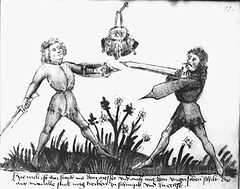
Hungarian shield
Encyclopedia


Targe
Targe was a general word for shield in late Old English. Its diminutive, target, came to mean an object to be aimed at in the 18th century....
. It was rectangular at the bottom, but the upper edge swept upward forming a curve. The elongated upper edge was designed to protect the head and neck against sabre
Sabre
The sabre or saber is a kind of backsword that usually has a curved, single-edged blade and a rather large hand guard, covering the knuckles of the hand as well as the thumb and forefinger...
cuts. They were characteristic for the Hungarian light cavalry
Hussar
Hussar refers to a number of types of light cavalry which originated in Hungary in the 14th century, tracing its roots from Serbian medieval cavalry tradition, brought to Hungary in the course of the Serb migrations, which began in the late 14th century....
. During the 16th century, the design became popular across much of eastern Europe, among both Christian
Christian
A Christian is a person who adheres to Christianity, an Abrahamic, monotheistic religion based on the life and teachings of Jesus of Nazareth as recorded in the Canonical gospels and the letters of the New Testament...
and Muslim
Muslim
A Muslim, also spelled Moslem, is an adherent of Islam, a monotheistic, Abrahamic religion based on the Quran, which Muslims consider the verbatim word of God as revealed to prophet Muhammad. "Muslim" is the Arabic term for "submitter" .Muslims believe that God is one and incomparable...
horsemen.
Up to the 15th century, this type was in use in Germany
Germany
Germany , officially the Federal Republic of Germany , is a federal parliamentary republic in Europe. The country consists of 16 states while the capital and largest city is Berlin. Germany covers an area of 357,021 km2 and has a largely temperate seasonal climate...
as well as in Hungary
Hungary
Hungary , officially the Republic of Hungary , is a landlocked country in Central Europe. It is situated in the Carpathian Basin and is bordered by Slovakia to the north, Ukraine and Romania to the east, Serbia and Croatia to the south, Slovenia to the southwest and Austria to the west. The...
. The 15th century German Gladiatoria
Gladiatoria
Gladiatoria is the name given to an anonymous mid 15th century German Fechtbuch, formerly kept at the Preussische Königliche Staatsbibliothek in Berlin, now at the Biblioteka Jagiellońska in Kraków, Poland...
fechtbuch
Fechtbuch
Martial arts manuals are instructions, with or without illustrations, detailing specific techniques of martial arts.Prose descriptions of martial arts techniques appear late within the history of literature, due to the inherent difficulties of describing a technique rather than just demonstrating...
depicts what it calls "ungrischer schilt" used by two fencers on foot. The upward sweeping edge is less pronounced than a point attached to the lower edge, apparently for offensive use, similar to a pata
Pata (weapon)
The pata, patta, dand patta or dandpatta is an Indian sword with a gauntlet integrated as a handguard. Traditionally, Maratha warriors were trained to fight with dual patas by bearing one in each hand. Alternatively, a single pata was used in addition to a belt, javelin, or axe in the other hand...
.
External links
- 16th century example (www.metmuseum.org)

